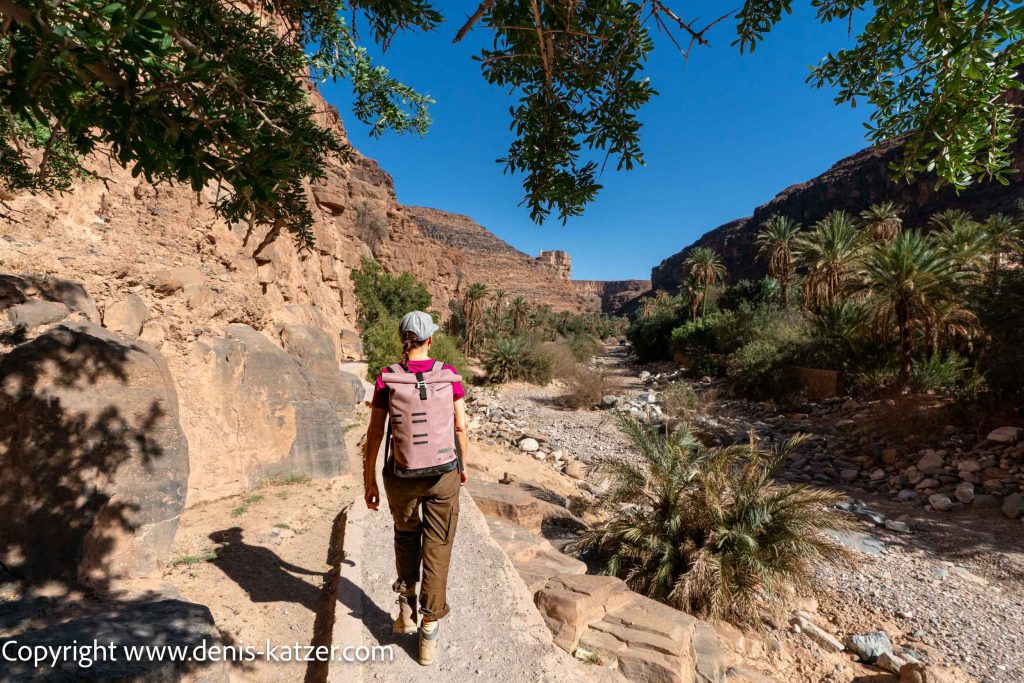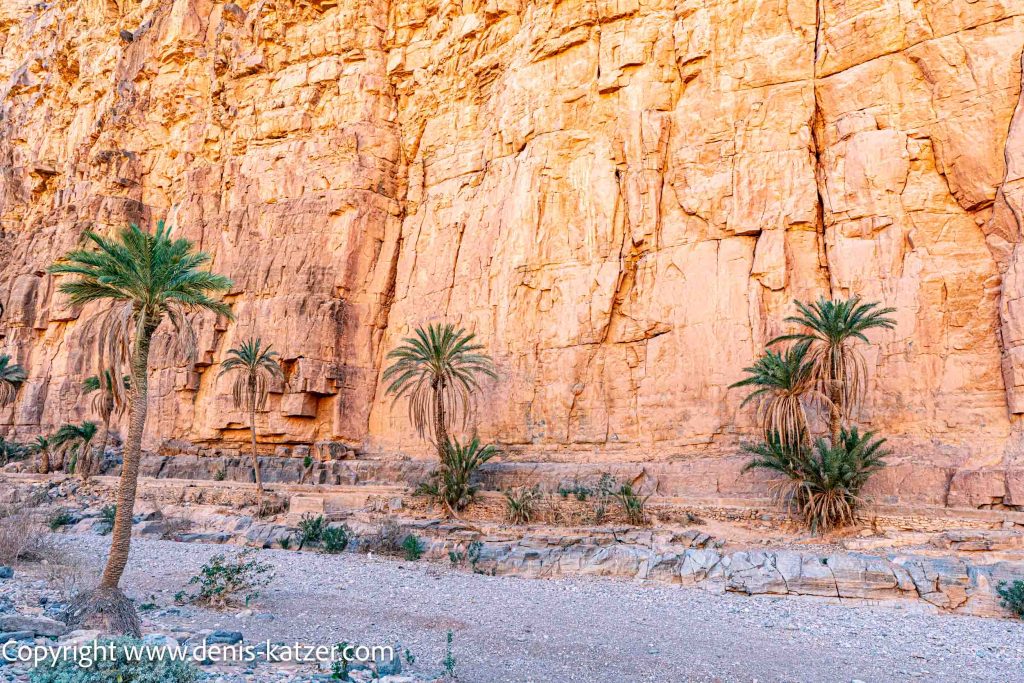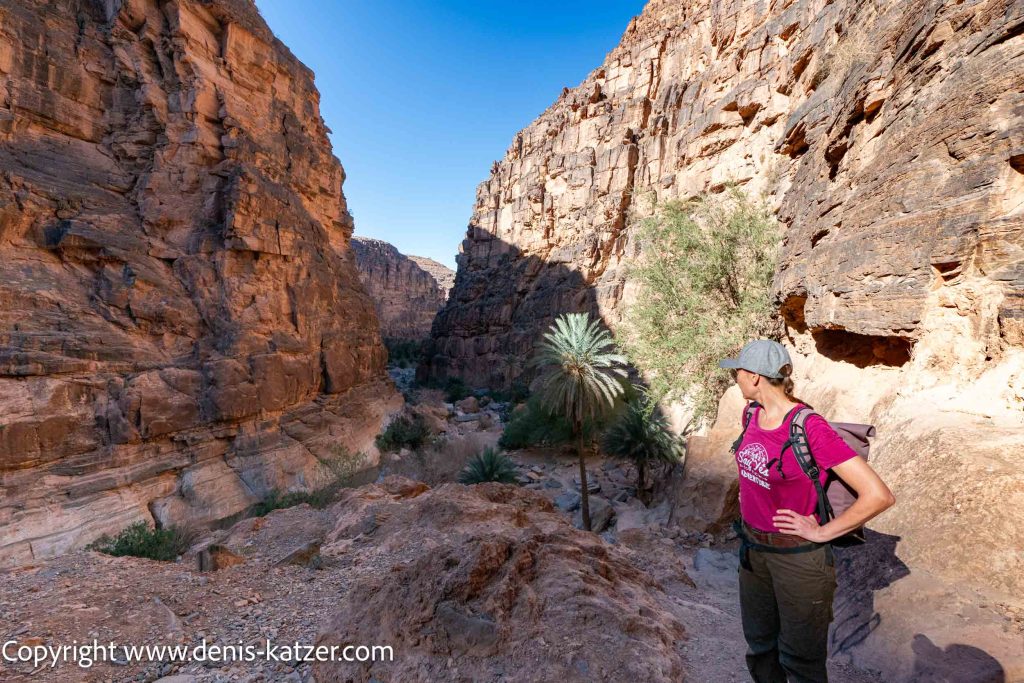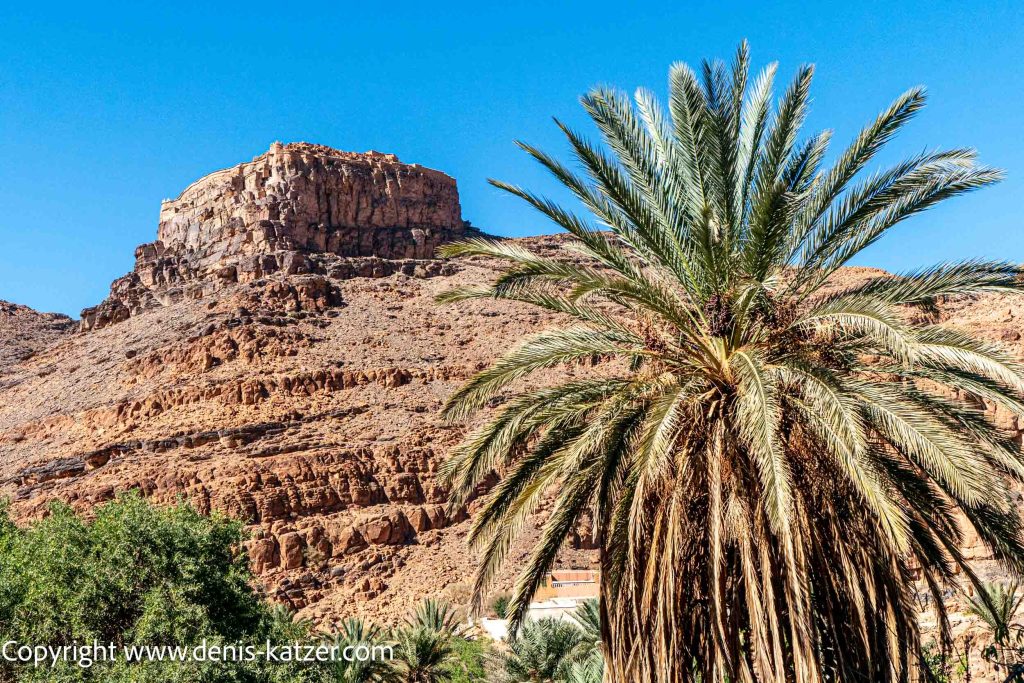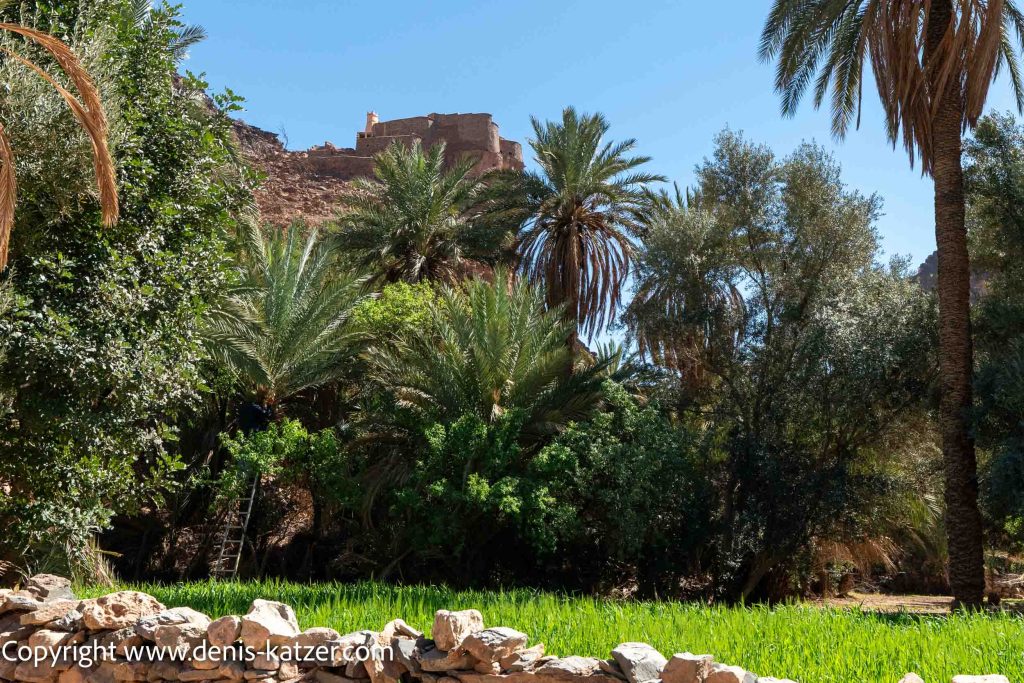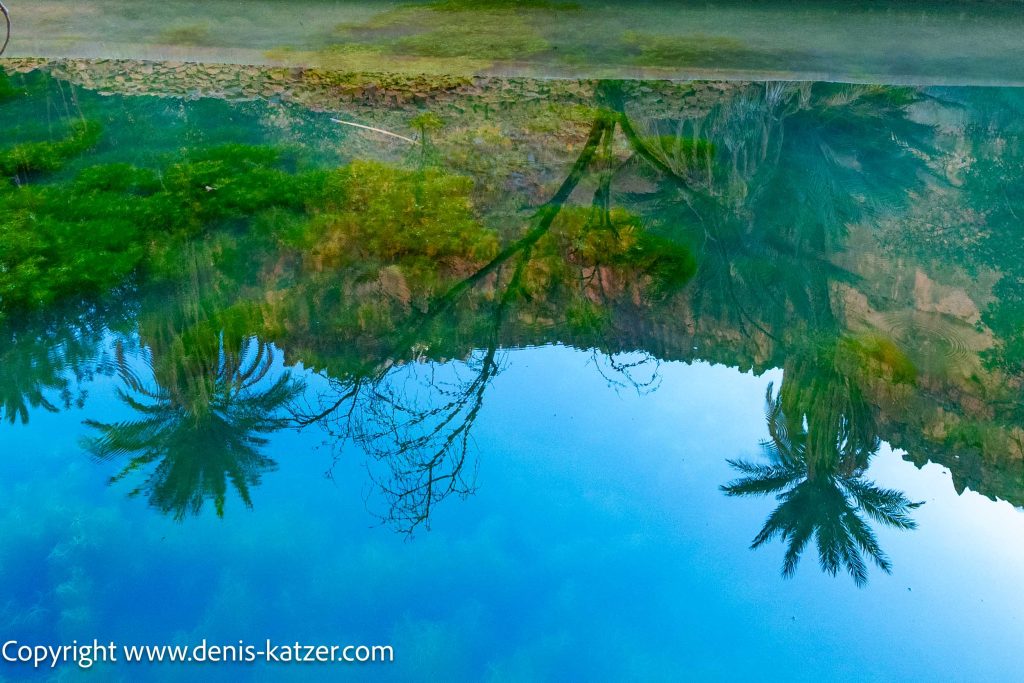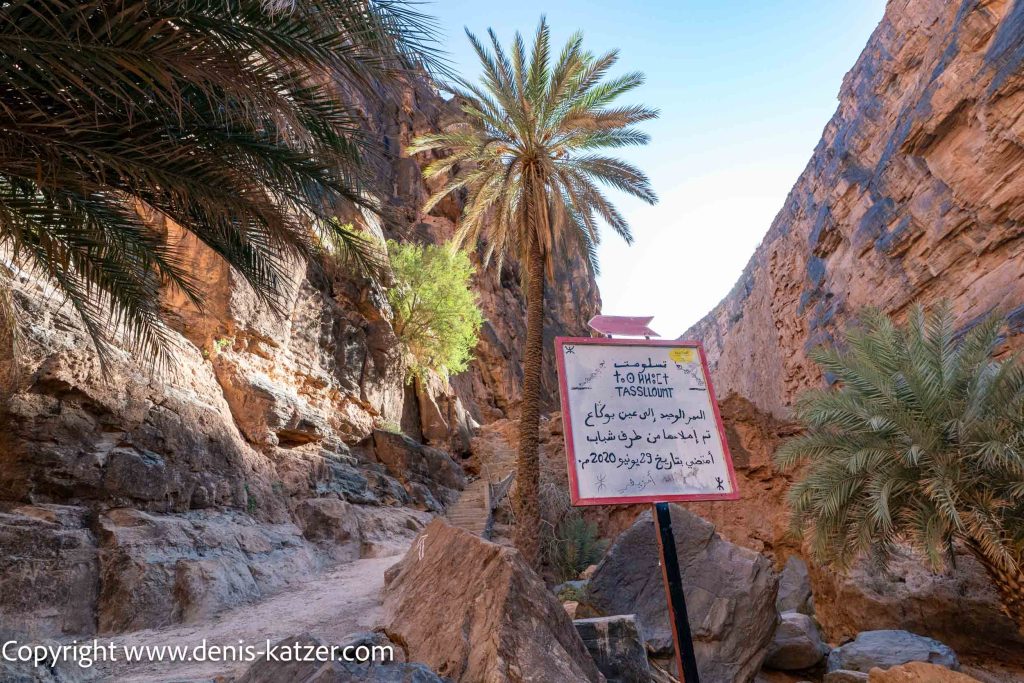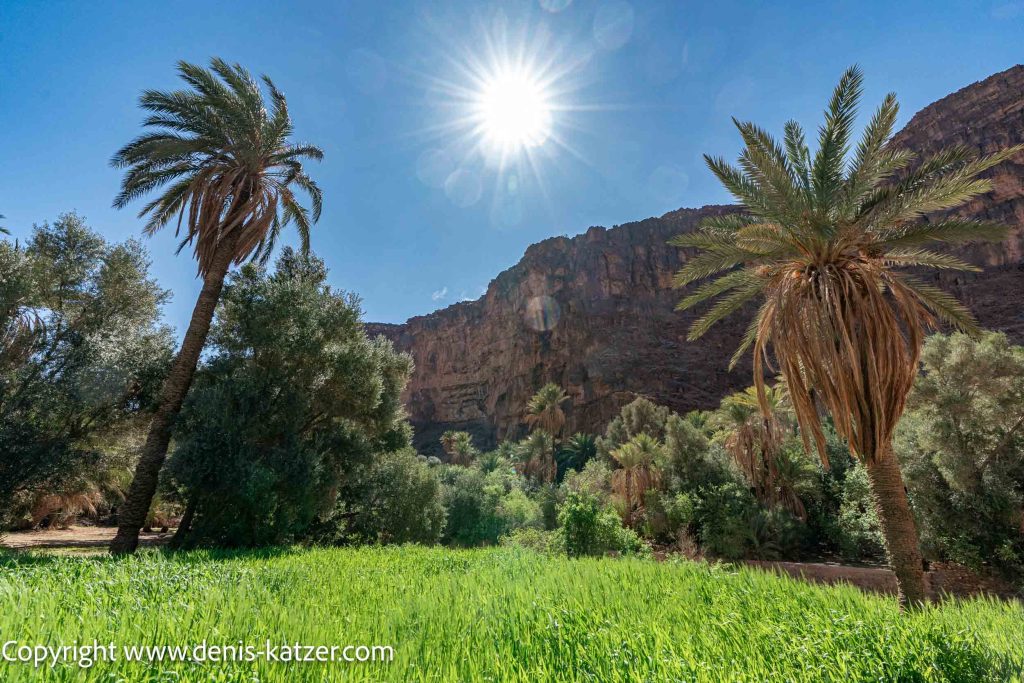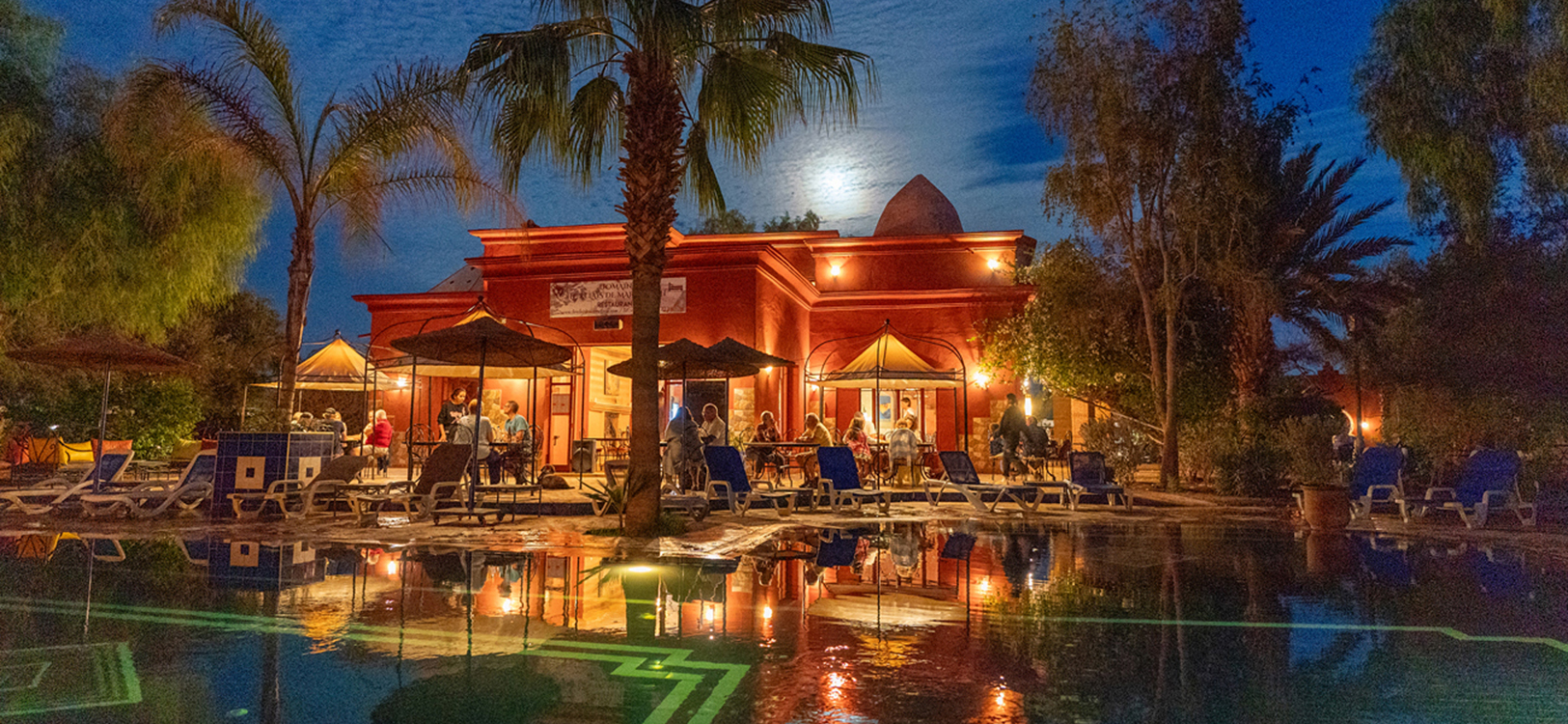
Leaving the motorhome behind and exploring the mysterious source of life by e-bike and on foot
N 29°14'35.5" W 009°11'31.3"
Day: 02/22/2024 to 02/23/2024
Day: 447 – 448
Camp 81
Country: Morocco
Location: Amtoudj village
Latitude N: 29°14’35.5″
Longitude W: 009°11’31.3″
Total kilometers: 12,020 km
Altitude: 726 meters
Temperature day max: 22°
Night temperature: 10 °
We had originally planned to spend just two days in this region to visit the impressive Agadir Id Aissa storage castle. However, the fascinating valley around the oasis village of Amtoudi, which is located in the south of Morocco in the Guelmim-Oued Noun region. captivated us so much that we decided to stay longer.
In the past few days, we have already explored the Speicherburg and undertaken an exciting e-bike tour into the Sahara, which borders the majestic Anti-Atlas Mountains here. Today we want to use our e-bikes again to visit the elongated oasis village of Amtoudi. It is hidden at the end of a barren lowland plain between two imposing rocky ranges and transports its visitors to a long-forgotten, almost magical era.
We are curious to see how far we will get with our e-bikes today, as we want to follow the small stream that babbles down the oasis gorge and has kept the village of Amtoudi alive with its life-giving water since time immemorial. Our aim is to explore the stream as far as possible, perhaps even reaching its mysterious source. The idea of following this ancient watercourse through the majestic landscape fills us with anticipation and a sense of adventure. Who knows what secrets await us at the end of this journey?
On our fascinating journey through the oasis village, we meet children who have just left school. Compulsory schooling was only introduced in Morocco in 1963. It applies to children between the ages of 6 and 15.
Despite compulsory education, long distances to school, poor infrastructure and economic constraints make access to education difficult in rural areas. However, the government has taken measures such as school construction projects and scholarships for families in need to overcome these challenges.
Amtoudi, with its 1,000 to 1,500 inhabitants, is a place where time seems to stand still and the old Berber traditions are still alive. The history of Amtoudi is a story of resilience, community and the deep connection between the people and their surroundings.
Legend has it that Amtoudi was founded many centuries ago by a wise Berber leader who was looking for a safe place for his people. After a long journey through the harsh landscapes of the Anti-Atlas Mountains, he discovered a fertile valley, protected by massive rocks and with a hidden spring that provided vital water. It is said that the name “Amtoudi” comes from an old Berber word for “place of protection”.
Life in oasis villages like Amtoudi has always been simple and closely connected to nature. The story of Amtoudi tells of adaptation and survival in one of the most challenging environments in the world, characterized by community, tradition and a deep connection with the environment.
We have now reached the old center of the village. As we hardly see any people in the alleyways, you could be forgiven for thinking that the oasis village has died out. However, this is more likely due to the high temperatures, which means that the villagers seek shelter from the heat during the day. Many people spend the hottest hours of the day in the cooler interiors of their houses or in shady places.
The traditional way of life follows a rhythm that depends on the climatic conditions. Agricultural activities and other work are often carried out in the early morning or late afternoon when it is cooler.
As in many cultures, especially in hot regions, it is customary in Amtoudi to take a longer lunch break. This time is used to rest and recover from the heat, which helps to make the village seem quieter during the day. The main activities, such as visiting the market or social gatherings, also take place in the early morning or late afternoon. During the day, people are therefore often busy with quieter, less visible activities.
Even for our e-bikes, it is difficult to make progress in some areas of the narrow alleyways. The alleyways in Amtoudi are designed this way for several practical reasons. Firstly, they contribute to natural cooling by providing shade and utilizing the wind tunnel effect, which keeps the temperatures in the alleyways more comfortable. Secondly, they provide protection from strong winds and sandstorms, which are common in the desert, and prevent sand and dust from entering the houses. Historically, the narrow alleys also provided a strategic advantage in the event of an attack, as they made it more difficult for attackers to move quickly around the village and allowed the inhabitants to defend themselves better. In addition, they enabled efficient use of the limited space in the desert region by creating dense, usable communal areas. Finally, the narrow buildings are part of the traditional architecture that has developed over centuries and is closely adapted to the climatic conditions and the way of life of the inhabitants.
The villagers maintain a close-knit community in which everyone is there for each other. Traditions and customs are passed down from generation to generation and the elders of the village play an important role as guardians of knowledge and history. Young people also have a variety of duties that are closely linked to traditional life in the village. They help with household and agricultural tasks, attend school and contribute to the community by maintaining religious and cultural traditions. They also support older villagers and take part in community projects. At the same time, they have to prepare for their professional future, which plays an important role in an increasingly modern world.
Modernity has also reached Amtoudi. Roads connect the village to larger towns in the region, and tourists like us find their way to this remote oasis to experience the unique architecture and untouched nature. With the tourists come new opportunities, but also challenges. The villagers are faced with the task of reconciling their traditional way of life with the new influences.
Some see tourism as an opportunity to preserve their cultural heritage and improve their economic situation. Others fear that contact with the outside world could jeopardize the village’s old customs and tranquillity. Nevertheless, Amtoudi remains a place that is deeply rooted in its traditions and retains its identity as an oasis village.
Unfortunately, it is the same here as in many rural areas of Morocco: young people are often drawn to larger cities in search of better educational opportunities and jobs. This leads to a slow exodus from the village, which has an impact on the local community and the preservation of the traditional way of life.
At the end of the village, the increasingly narrow path forces us to leave the village and continue our tour along a dry riverbed. Although our e-bikes are suitable for off-road use, we find it difficult to make progress in the soft scree. In the end, we have to push the bikes, which is extremely tedious. We decide to leave the bikes in a shady spot under the palm trees and continue the tour on foot. One of the village elders promises to look after our bikes in the meantime. “Nobody steals here. It’s a matter of honor,” he says with a laugh. Relieved, we pack our rucksacks and set off, hoping to reach the source of the life-giving vein of water today after all.
We leave the bikes behind
The very first steps on our hike through the oasis valley feel as if we have entered the gateway to another, wonderful world. It is as if we have stepped into a fairytale where all worldly worries have disappeared. The chirping of crickets fills the hot air, a gentle wind rustles the leaves of the palm trees softly and the soothing lapping of the water accompanies us at every turn.
This is exactly how I imagined an oasis as a child: full of life, carefree and surrounded by lush greenery. In the Amtoudi oasis, a picture of fairytale beauty unfolds before our eyes. The beautiful nature and peaceful atmosphere allow us to feel the magic of this place deep within us as we continue to immerse ourselves in this paradise.
Berber women sit in the shade of palm and almond trees and weave wonderful coasters, which they sell to the occasional hiker passing by. They welcome us with a warm greeting and a beaming smile.
We are surprised by the impressive variety of agricultural products that are perfectly adapted to the climate and geography of the region. Date palms are the absolute highlight here – they are not only an important source of food, but also a valuable commodity that is sold at the local markets. In addition to the sweet dates, grains such as wheat and barley also grow here, which form the staple diet of the villagers.
But that’s not all! The fertile soils of the oasis also produce a rich harvest of vegetables such as onions, carrots, tomatoes and zucchinis, which perfectly complement the daily diet. And then there are the fruit trees: figs, pomegranates and olives provide delicious, nutritious fruits that play a major role in the local cuisine. The whole thing is rounded off with pulses such as beans and lentils, which are a valuable source of protein. A real paradise for anyone who appreciates fresh, natural food!
Suddenly we catch sight of another storage castle, built centuries ago by the local Berber clans in spectacular style on a rocky outcrop. A few days ago, we had already explored the Agadir Id Aissa storage castle at the head of this valley. The reason why there are two such imposing structures within a few kilometers of each other could be due to the size of the community, the social structure or the need to store supplies separately for different parts of the village. It was common for different tribes or family groups to have their own agadirs to secure their supplies independently of other groups. In addition, the number of storage castles could have been a sign of the prosperity or strategic importance of the village.
During our hike through the valley, we repeatedly come across the irrigation system, which is based on the traditional Khettara system. This ingenious technique was developed especially for desert regions and is several centuries old in Amtoudi. The system was established in the region over 1,000 years ago, although the exact date of origin can vary depending on the region and local history. Many of these systems date back to the early Middle Ages. Khettaras are underground channels that drain water from higher springs and transport it through the desert to the oasis. The system cleverly uses gravity to slowly and efficiently channel the water to the fields and gardens.
The Khettara system is particularly effective because it minimizes evaporation and ensures an even distribution of water. The villagers ensure that the water supply runs smoothly by regularly maintaining and cleaning the channels. This traditional irrigation method is not only functional, but also an important part of Amtoudi’s cultural heritage. It promotes community cohesion and enables sustainable agriculture in the dry desert environment.
After a while, the path created by the Oasis settlers ends abruptly and we are forced to climb over sometimes slippery rocks and follow the riverbed. The gorge becomes increasingly steep and narrow, making the ascent more challenging. A few markings painted on the rocks indicate that this trail is officially designated as a hiking route. However, despite the markings, climbing here requires attention and caution. The path may not be technically too difficult, but you should definitely wear good shoes and be sure-footed to safely negotiate the steep and uneven sections. The challenge of the ascent is rewarded by the spectacular views that present themselves time and again as we leave another section of the gorge behind us. Up here, you can feel the untouched wildness of the landscape, which is the charm of this remote region.
“Look, there are fish in the water!” Tanja exclaims in surprise, pointing to one of the pools left behind by the Oued Amtoudi river, which has now almost dried up. Its partly wide bed, littered with large pebbles polished by the water, is evidence that the river can carry a lot of water during the rainy season, which lasts from November to March. How the fish got here is not entirely clear to us. Perhaps they were introduced by the inhabitants of the oasis to provide an additional source of food. Or have they arrived here through underground water connections and interconnected cave systems?
The water that feeds the oasis often comes from the mountains around the region, particularly from the high altitudes of the Anti-Atlas Mountains. Rainwater that falls in higher regions seeps into the ground and collects in underground reservoirs or aquifers. These springs feed the rivers and streams that then flow through the oasis. In the higher regions of the Anti-Atlas Mountains, there can even be occasional snowmelt, which also contributes to the water supply in the region.
The later the hour, the lower the sun sinks behind the high rock faces, which enclose the oasis valley ever more tightly and gradually turn it into a narrow gorge. The shadows grow longer as the sunlight fades. We ask ourselves whether we can still make it back in the remaining daylight and are faced with the decision of whether it makes sense to continue or whether it wouldn’t be wiser and safer to turn back. Under no circumstances do we want to risk stumbling over the sometimes damp and slippery rocks in the dark and possibly injuring ourselves. Despite our reservations, we decide to continue a little further.
“That’s the end of the path!” I shout as we reach a steep cliff a little later. About 50 meters below us, the small stream meanders through a narrow gorge. “Wow, what an incredibly beautiful and impressive valley,” says Tanja, tilting her head back and gazing at the glowing red rock faces, which seem to be burning in the last of the sunlight.
On our way back, we realize more and more that this oasis is located in the largest desert in the world, the Sahara. It is a symbol of life in a world of silence and emptiness.
Here, where the sea of sand meets fertile land, we are on a journey that is more than just a step from one place to another. It is a journey to the origins, to the sources of life.
The first steps into the oasis felt like immersing ourselves in a dream. The heat of the desert subsided and the gentle murmur of the hidden water reminded us of the mystery of life. It is as if the earth breathes here, and every element of nature speaks of perseverance and resilience.
As we follow the narrow paths, we feel connected to the timelessness of this place. Centuries may have passed, but the oasis remains a symbol of life itself. Our minds have become calm and in tune with the wisdom emanating from the palm trees and ancient rocks.
The desert may be unforgiving, but in the oasis it shows its merciful side. The clear waters of the springs reflect the sky and whisper: “Even in the darkest times, there is light.” This realization makes us pause and understand the oasis as a metaphor for life – a life that makes us aware of our transience, but also makes us aware of the importance of every moment.
Here we have discovered a place that exists beyond space and time, and in it we have found the truth: Life, as barren as it may seem at times, always finds a way to flourish.
Here is the link to the video:
